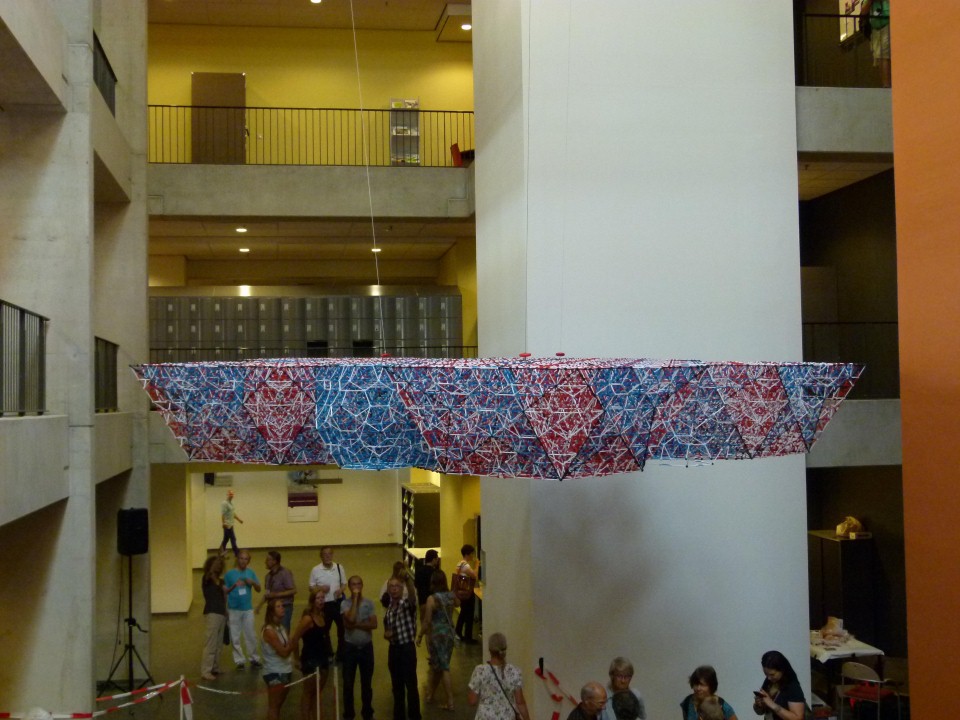2013 Zometool Giant Construction

The Annual Zometool Giant Construction is a Bridges community event that is supported by Zometool Inc. During this event the participants work on a giant Zometool sculpture, on a walk-in basis, starting on the first day of the conference. This year's project will be completed on 29 July 2013, to give sufficient time to the builders and the entire Bridges Conference participants to visit the site and enjoy the structure and celebrate. The following are some images from previous constructions.
Short description of the Pentidisc
Moiré patterns, quasiperiodic tilings, and Padovan sequences are concepts that mathematicians might think to be unrelated. But the hand of a great artist can show their deep inter-relationships and reveal the dazzling beauty they engender.
After a luminous design career ranging from graphics to furniture to city planning (he worked with Le Corbusier), and spanning 70 years, one might expect Fabien Vienne to slow down a little bit. But rather, he continues all the more vigorously to explore new concepts, investigate new lines of thought, and discover new results in his pursuit of truth and beauty.
For the Bridges 2013 Zometool sculpture, Fabien has designed "PentiDisc", a sculpture that completely merges the seemingly disparate mathematical concepts mentioned above. The design presents formidable challenges: it consists of more than 90,000 parts. It will be the largest Zometool construction ever built. And there are engineering challenges too: a pentagonal disc 5.7 meters in diameter, covered with quasiperiodic tilings, suspended almost 4 meters above the ground, built by an international group of artists and mathematicians. It's just one of the delights offered at Bridges 2013, Enschede, where art and math make love.
Mathematical background
Mathematicians describe grids radiating in multiple directions from a common center as "Exceptionally singular". In the quest for quasiperiodicity, mathematicians have rarely used exceptionally singular multigrids (conceptually simple but, paradoxically, computationally complex), opting instead for "uncentered" approaches that, while computationally manageable, are difficult for the nonmathematician to visualize. Vienne's exceptionally singular PentiDisc reawakens nonmathematicians and mathematicians alike to the richness of quasiperiodic tilings built from a visually recognisable "exceptionally singular" centre. The 5.7-meter PentiDisc embodies a small slice of a 3-dimensional space organized in 5-fold symmetry.
Initially, the matrix was experientially explored and built as follows: Symmetrically arrange 5 cubes within a dodecahedron, then extend each cube to become a lattice of cubes. There are multiple "nodes" where 3 or more lines "cross" (in fact the only place where they will precisely cross is the exceptionally singular centre). Then rank the crossings by their relative imprecision, and connect crossings with similar degrees of imprecision. What results is a quasiperiodic tiling. By then connecting the next ranking of imprecisions, the same pattern will be found, fractal fashion, enlarged or reduced in the golden ratio. No artistic decisions have been made. The resulting art has built itself! For people who think most easily in 3 dimensions, the cubic-lattice approach is a good way to visualise this spatial matrix. For people who think more readily by beginning from 2 dimensions, the matrix can also be visualised as follows: In a common plane, symmetrically arrange 5 sets of parallel lines ("multigrids") around a common centre. Then arrange 6 planes like that in such a way that each plane contains one of the 6 great circles of a central icosidodecahedron. This central icosidodecahedron is easily recognised in the PentiDisc.
